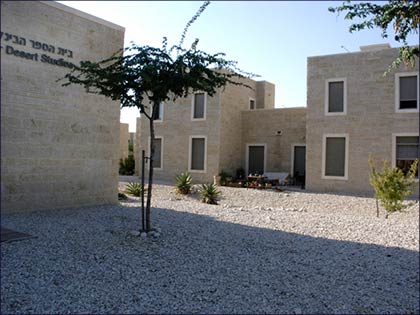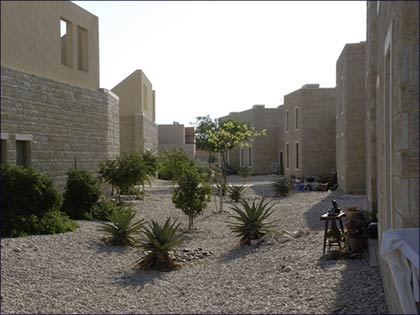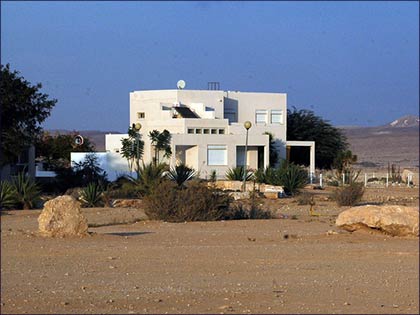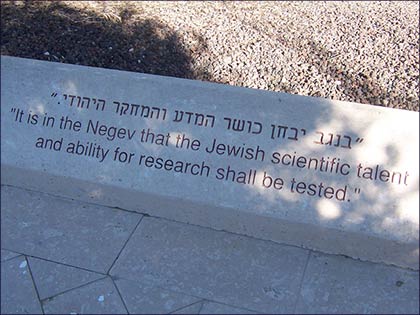By Avigayil Kadesh
When the state of Israel was just four years old, Prime Minister David Ben-Gurion was traveling with his driver-bodyguard through the Negev Desert and noticed a few tents pitched alongside the road to Mitzpeh Ramon. He asked his driver to stop and investigate.
What the men found was a group of 13 recently discharged soldiers establishing a ranch to raise horses and cattle (Sde Boker means “Cowboy Field”). The 67-year-old head of state was so impressed with these young pioneers that he asked to join them when their venture officially became a kibbutz the following year.
The prime minister was no shoe-in; his application was duly considered and voted upon by the members. It was only by a slim majority that Ben-Gurion and his wife, Paula, were able to join and retire in 1963 to Kibbutz Sde Boker.
Today, the name “Ben-Gurion” is synonymous with the Negev and particularly with Ben-Gurion University, Kibbutz Sde Boker and Ben-Gurion Village.
Ben-Gurion Village is a unique academic and residential community built upon the fields where the Prime Minister ended his daily mile-long walks from his modest kibbutz home – often in the company of Israeli and foreign VIPs.
The village, now celebrating its 50th year, is a vital educational and employment hub for the families who live in the small municipalities of the widely spread-out Ramat Hanegev Regional Council. It is also the internationally recognized address of cutting-edge research in ecology and desert agriculture, drawing thousands of foreign students and scholars each year.

Albert Katz International School for Desert StudiesNew families moving in each year
“Midreshet Ben-Gurion was established in 1963 with a field school,” says Eran Doron, director of education and community activity for the village (“For residents from age zero to 100, I’m responsible,” he jokes).
“It has become a respected place for education and research through the vision of Ben-Gurion, who wanted to establish in the Negev an ‘Oxford’ for research and a ‘Yavneh’ for Torah education -- not just in the religious sense of the word.”
Doron explains that because people can receive quality educational services here from kindergarten to post-doctorate programs, Ben-Gurion Village has become the largest community in the regional council, with 400 families and growing. Real-estate prices have shot up recently due to demand, as 30 to 40 new families seek to move in each year.

New homes in the desert community“We have doubled our population in the last five or six years after many efforts toward preserving the unique character of the place,” says Doron, who estimates that 1,500 people live in the village, counting the high school and graduate students living in dormitories.
The character he speaks of is defined by ecology and sustainability, most visibly evidenced by houses built most efficiently for the desert climate, and huge recycling centers for the small population.
“If in central Israel the average street has five lawyers, three accountants and two dentists, in Midreshet Ben-Gurion we have the largest amount of nature reserve rangers living here, and most of our residents are very environmental-minded.”
Israel’s only high school for future ecologists
An environmental studies high school, the only one of its kind in the country, is giving 300 students from across Israel a head start in careers as environmentalists, biologists and ecologists.
Right here is located Ben-Gurion University’s Jacob Blaustein Institutes for Desert Research (BIDR), established in 1974 to carry out research on the desert environment in order to promote sustainable uses of the Negev and other arid lands the world over.
BIDR also operates the Albert Katz International School for Desert Studies , which is responsible for all training and teaching activities at the institutes, and the Blaustein Center for Scientific Cooperation, offering post-doc programs and collaborations with other research and academic institutions around the world.
Research institutes at heart of the village
“We are one of the reasons for the major development in this area,” acknowledges Prof. Pedro Berliner, BIDR director and a world expert in the soil-plant-atmosphere continuum.
“We are physically located in this small village, and 50 percent of the people who work here also live here in addition to most of our 150 students,” says Berliner. “About 20-30 percent of our students are married and have children who attend school here. So we have extremely strong interactions with all the local educational operators.”
The high school is not formally affiliated with BIDR, but high school teachers are paired with PhD students in a scholarship program to run special seminars, and BIDR graduate students often explain their research in the elementary school classrooms.
BIDR also sponsors cultural activities, such as the annual Tel Hai International Piano Master Classes, a month-long event attracting pianists from all over the world to take classes and give concerts for the public.
The government of Ecuador recently requested a BIDR team to go to the Galapagos Islands and do a study on invasive species of plants and animals that have resulted from the high volume of tourism on the islands.
Berliner, who has lived locally for 26 years and ran two experimental farms for the institutes before taking the directorship almost three years ago, emphasizes that the institutes are a source of employment for the entire adult workforce of Ben-Gurion Village, from caterers to electricians.
Back at the kibbutz
It was David Ben-Gurion’s love for Sde Boker and the greater Negev that led to the creation of the village named for him. He is one of only two Israeli prime ministers buried outside of Jerusalem (the other is Moshe Sharett, buried in Tel Aviv) and his gravesite stands at the center of a national park between the kibbutz and village overlooking a picture-perfect view of the Tsin canyon and the Avdat highlands.

A typical house in Midreshet Ben-Gurion Kibbutz Sde Boker no longer resembles the dusty row of tents that Ben-Gurion fell in love with in 1951. The manicured kibbutz is visited often by tour groups, who will see prescient Ben-Gurion quotations about the Negev inscribed on stones lining the main walkway.
Because wine grapes grow well in the desert soil and climate, a winery was started on the kibbutz about 10 years ago by an immigrant from Napa Valley, California. Kibbutz Sde Boker also produces olives and pistachios from its ground and Davik packaging tape at its factory.
The highlight of a tour of Kibbutz Sde Boker is the preserved Ben-Gurion Desert Home . After the retired prime minister’s death in 1973, the house was opened to visitors according to his last will and testament.
The Desert Home is not even remotely similar to, say, the White House or even the official Israel President’s Residence in Jerusalem. Like the rest of the homes on the kibbutz, it was originally, a modest hut; it was slightly expanded over the years to accommodate Ben-Gurion’s work needs and the couple’s many guests.
Know the house, know the man
Guide Ronit Barak points out that no photos of Ben-Gurion’s three children hang in his bedroom – those are found in the adjacent bedroom of Paula, who chose not to share a room with her husband because he always worked through much of the night.
The portraits that do take prominence are those of Ben-Gurion’s personal heroes: the biblical Moses, who led the Jewish nation from slavery in Egypt to freedom at the border of what is now Israel; Abraham Lincoln, the American president who prevented the division of the United States and abolished slavery; and Mahatma Gandhi, who led India to independence and is a symbol of non-violent resistance.
Ben-Gurion received many gifts from various dignitaries and institutions, and those he chose to display in his home reflect things that were close to his heart, Barak explains: a painting of the state emblem with his portrait and that of his friend Itzhak Ben-Zvi; a copy of Israel’s Declaration of Independence received from Golda Meir; a Hanukah menorah that plays the national anthem; and a 1952 map of Israel.

Kibbutz Sde Boker features path markers with quotations from David Ben-Gurion about settling the NegevThere are 5,000 books shelved in the library (and another 22,000 in Ben-Gurion’s restored Tel Aviv house), spanning Judaism and Bible, philosophy, history and geography, sports, culture, military and security – in nine languages because Ben-Gurion believed in reading in the original. “Any subject but cooking and music you can find here or in his house in Tel Aviv,” says Barak.
Why trek down to the Negev to see the Desert Home? “A person’s home reflects his personality characteristics and views of his life, and this is actually the only aspect of Ben-Gurion you cannot get from history books or the Internet,” says Barak.
Tours are also available at Ben-Gurion Village.